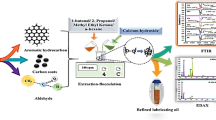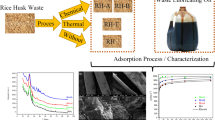Abstract
In order to explore the high value-added utilization of flyash adsorption in regenerating waste lubricating oil, the main factors related to the flyash adsorption was investigated by the single-factor tests, and then the optimum process conditions for flyash adsorption was obtained by means of the orthogonal experiments, and in terms of several indexes, such as kinematic viscosity (40 °C), acid number, mechanical impurity and moisture, the combined process of flyash adsorption/solvent extraction was discussed and finally compared with previous studies. The experimental results prove that flyash has a good effect in adsorbing waste lubricating oil, and the solvent extraction-flyash adsorption process has a better effect in the regeneration of waste lubricating oil than the flyash adsorption-solvent extraction process.




Similar content being viewed by others
References
Abdel-jabbar NM, Zubadidye AHA, Mehrvar M (2010) Waste lubricationg oil treatment by adsorption process using different adsorbents. World Acad Sci Eng Technol 4(2):9–12
Ahmaruzzaman M, Gupta VK (2012) Application of coal fly ash in air quality management. Ind Eng Chem Res 51(47):15299–15314
Al-Ghouti MA, Al-Degs YS (2011) New adsorbents based on microemulsion modified diatomite and activated carbon for removing organic and inorganic pollutants from waste bricants. Chem Eng J 173(1):115–128
Dai JL (2009) Regeneration of waste lubricating oil(4th edition). China Petrochemical Press, Beijing, pp 1–15
Gao NW, Ke W, Fan YQ et al (2009) Regeneration of wasting lubricating oil. Chemical Industry and Engineering Progress 28(2):414–418 (in Chinese)
He SQ (2002) Application of fly ash in regeneration of waste lubricating oil. China Resources Comprehensive Utilization 7:23–24 (in Chinese)
Hsu YL, Liu CC (2011) Evaluation and selection of regeneration of waste lubricating oil technology. Environ Monit Assess 176(1–4):197–212
Huang YB, Qian JS, Zhang JY (2009) Influence of high-iron fly ash on absorption property of cement based materials. Function Materials 40(11):1787–1790 (in Chinese)
Kim MJ (2010) Method for treating carbon dioxide in power plant gas and recycling calcim carbonate by use of coal ash of anthracite-fired fluidized bed power plants. KR:2010131 895A, 2010-12-16
Liu JL, Wang QP, Min FF et al (2017) Modification of flyash and its adsorption of oily wastewater. New Chemical Materials 45(1):243–245 (in Chinese)
Li XH, Wu JJ, Jiang GQ et al (2016) Progress in regeneration technolgies for used lube oils[J]. Petrochemical Technology 45(2):244–250 (in Chinese)
Liu XY, Ouyang P (2016) Present situation and development trend of regeneration method applicated in adsorptive material. New Chemical Materials 44(6): 7–9, 12
Liu ZC, Shi XY, Li YG et al (2018) Lanthanum modified flyash for the removal of phosphorus and nitrogen. New Chemical Materials 46(2):205–208 (in Chinese)
Li Z, Li C (1997) Test for regeneration of transformer oil by high efficient absorbent. Transformer 34(11):35–37 (in Chinese)
Li Z, Wang MH, Qian YH et al (2001) Experimental study on the regeneration of deteriorated fire-resistant oil by flyash from power plant. Thermal Power Generation 16(5):65–66 (in Chinese)
Liu ZN (2009) The preparation and application of the molding flyash adsorbent. Chemical Industy Press, Beijing, pp 29–35 (in Chinese)
Ma QL, Liao JJ, Zong RH, et al. (2016) Adsorption of methylene blue from aqueous solution using FA/PAA composite microgels. Bulletin of the Chinese Ceramic Society 35(2): 380–385, 391
Peng NY, Yu P, Luo YB et al (2001) Research on a new kind of spherical adsorbent for the regeneration of transformer oil in the daya wann nuclear power station. High Voltage Enigeering 27(3):55–57 (in Chinese)
Ren XJ, Zhang XB, Liu XQ, et al. (2006) Preparation of porous ceramic membranes from fly ash. Journal of Materials Science & Engineering 24(4): 484–488
Su Y, Fang HF (2016) Research on fly ash policy in China. Clean Coal Technology 22(4):52–55 61
Wei N, Wang XL, Guan WX (2015) Synthesis of pure zeolite coal fly ash for ammonium removal. Chinese Journal of Environmental Engineering 9(2):795–799
Wu L, Liu Y, Sun YX et al (2015) Study on the regeneration of waste lubricating oil based on solvent refining with sulfolance. Applied Chemical Industry 44(5):858–860, 870 (in Chinese)
Xie CB, Qian JS, Zhang ZW et al (2013) The effect of shale and fly ash on the dehydration property of sewage sludge. Function Materials 44(10):1437–1441 (in Chinese)
Xu PY, Zhao Y, Li YQ et al (2009) The preparation and characteristic study on simultaneous desulfurization and denitrification based on oxygen-rich highly active absorbent. Function Materials 40(9):1545–1548 (in Chinese)
Yang L, Cai F (1997) Study of coal ash utilization in waste lubricant regeneration. Comprehensive Utilization of Coal Ash 2:19–22 (in Chinese)
Yang X, Chen LG, Zhu LY et al (2012) Regeneration of waste lubricating oil based on three carbon alcohols solvent refining. Acta Petrolei Sinica(Petroleum Processing Section) 28(6):1031–1036 (in Chinese)
Yang XP, Zhang XM, Ouyang P (2015) Research progress in recycling technology of waste lubricationg oil. J Chongqing Technol business Univ.(Nat Sci Ed) 32(2): 96–99. (in Chinese)
Yu HC, Feng Y, Jian XL et al (2009) Used lubricating oil recycling using a membrane filtration: analys is of efficiency, structural and composing. Desalin Water Treat 11(1–3):73–80
Yuan MH, Liu YJ (2012) Preparation of fly ash supported catalysts for treatment of methyleneblue. Environmental Science& Technology 35(3): 104–110
Zeng LX, Li WJ, Zhuang YJ et al (2015) Deep treatment of low concentrated phosphorus by flyash. Chinese Journal of Environmental Engineering 9(4):1778–1782
Zhang XM, Dong Y, Wu Y, et al. (2014) Research on the decolorization technology of waste lubricating oil and its application. Applied Chemical Industry 43(6): 1128–1132
Zhao XG, Liu ZN, Liu Y et al (2009) Preparation of coal flyash based forming adsorbent and its adsorptive properties for methylene blue. Chin Ceram Soc 37(10):1683–1688 (in Chinese)
Zuo JZ, Jiang JH, Ma AB, et al. (2011) Microwave absorbing performance of electroless Co-Ni-P alloy coating on flyash hollow microspheres. Materials Protection 44(4): 15–12
Author information
Authors and Affiliations
Corresponding author
Additional information
Responsible editor: Philippe Garrigues
Publisher’s note
Springer Nature remains neutral with regard to jurisdictional claims in published maps and institutional affiliations.
Rights and permissions
About this article
Cite this article
Ouyang, P., Zhang, X. Regeneration of the waste lubricating oil based upon flyash adsorption / solvent extraction. Environ Sci Pollut Res 27, 37210–37217 (2020). https://doi.org/10.1007/s11356-019-07389-9
Received:
Accepted:
Published:
Issue Date:
DOI: https://doi.org/10.1007/s11356-019-07389-9




